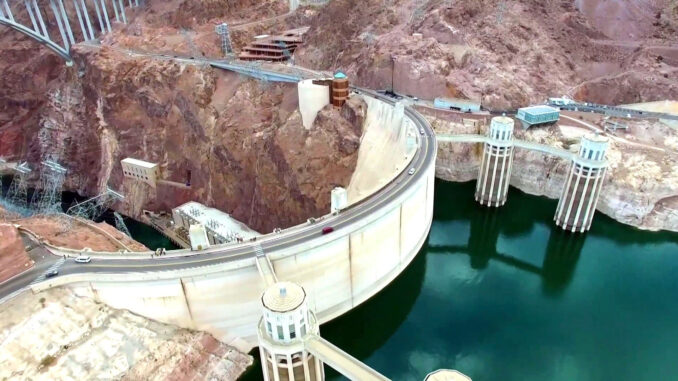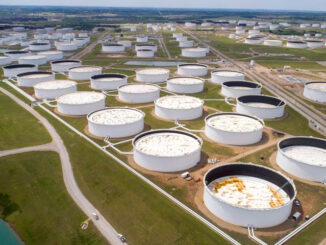
Amid a prolonged drought in the West, the reservoir created by the Hoover Dam sunk to its lowest level ever last month — and that’s raising concerns about reduced output from the dam’s hydroelectric plant, which sends more than half its power to Southern California.
Stationed on the main stem of the Colorado River in the Mojave Desert along the Arizona-Nevada border, about 30 miles east of Las Vegas, Lake Mead was formed in the 1930s from the damming of the Colorado River. It’s the largest reservoir by volume in the United States. It not only provides water across the Southwest but also generates electricity at one of the largest hydroelectric plants in the nation.
Now, as parts of the western U.S. remain in the grips of a possible “megadrought,” Lake Mead’s historically low water levels are adding a layer of uncertainty to electric reliability this summer.
“Six years ago, when we were here … I recall that the water was a lot higher,” said Hugo Cuevas, a tourist who recently visited the dam. “We’re actually very surprised at how low it’s gotten, how shallow it looks.”
As of last week, the reservoir was about 158 feet below its full level, according to Doug Hendrix with the federal Bureau of Reclamation. A white “bathtub ring” of mineral deposits left by higher water levels on the rocks around the lake marks how much water has retreated over time.

“We’ve been creeping down to this level for quite some time now, for the last 22 years,” Hendrix said.
The reservoir’s capacity is variable, but Lake Mead is defined as “full” when the water line reaches an elevation of 1,221.4 feet above sea level, according to the Bureau of Reclamation. As of Monday, when the bureau released its latest report, Lake Mead was at a record-low elevation of 1,069.4 feet above sea level.
That’s roughly 35% of its capacity.
The previous record of its low water level was set in 2016 at 1,071.6 feet above sea level. The lake has been below that historic low since June 10, when it fell to 1,071.56 feet above sea level.
Meanwhile, officials expect water levels to get worse through the summer.
In the U.S. Drought Monitor’s 20-year history of tracking drought, the West and Southwest are drier than they’ve ever been.
California Gov. Gavin Newsom has now declared drought emergencies in 41 of the state’s 58 counties, encompassing 30% of the state’s population. None of those counties are in Southern California, though the region is also seeing severe and extreme drought.
The worsening drought impacts water supply and the efficiency of hydropower generation at Hoover Dam, as water is used to spin turbines to produce electricity. Water enters the dam’s iconic Art Deco intake towers and flows down penstocks, or pipes, to the turbines, which power the generators.
The current turbines can operate and generate power as long as the water level remains above 950 feet, according to the Bureau of Reclamation. But less water means less pressure, and less electricity generated to send out to the grid.
“Under full reservoir conditions, we can generate about 2,074 megawatts of power here, enough for around a million residents,” Hendrix said. “Because of the lower reservoir conditions, unfortunately now we’re down to only generating about 66% efficiency.”
According to the Bureau of Reclamation, more than half of the electricity generated at the dam goes to Southern California.
With the West expected to get little reprieve from scorching temperatures and the ongoing drought, the demand for power is likely to continue to increase throughout the summer, which will increasingly push California’s stressed power system to the brink.
The California Independent System Operator, which oversees the grid in most the state, has already asked residents to conserve power to avoid triggering brownouts and shortages. Last summer, a heat wave overwhelmed the state’s power grid, triggering the first power shortages since the 2001 energy crisis, when power traders deliberately manipulated supplies.
Meanwhile, the North American Electric Reliability Corp., a nonprofit regulatory agency that works to prevent power failures in the U.S. electrical grid, put California at a “high risk” of energy emergencies this summer.
But John Moura, director of reliability and performance analysis at NERC, said the organization has been assessing the situation in California and doesn’t expect any large-scale or lengthy outages.
“We are confident the electric system operators have everything they need to maintain the reliability stability of the system,” Moura said of NERC’s assessment of California’s energy grid.
But in the long term, he said extreme weather events caused by climate change may change the stability of the power grid.
“Weather is one of the most impactful forces on the electricity system, the equipment, the things we use to power our electricity grid,” Moura said.
“As we change our grid to rely more on resources that are more vulnerable to extreme weather, areas that are perhaps more reliant on hydro or solar become more vulnerable to these larger environmental changes that seemingly are increasing in terms of extreme weather.”



